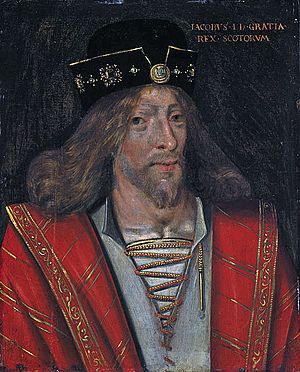Robert Stewart, Duke of Albany facts for kids
Quick facts for kids Robert Stewart |
|
|---|---|
| Duke of Albany Earl of Fife |
|
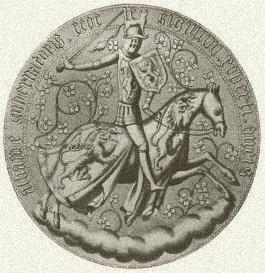
Lithograph of the reverse of the 1413 seal of Robert Stewart as Governor of Scotland
|
|
| Born | c. 1340 Dundonald Castle |
| Died | 3 September 1420 (aged c. 80) Stirling Castle |
| Spouse |
|
| Issue more... |
|
| House | Stewart (Albany branch) |
| Father | Robert II of Scotland |
| Mother | Elizabeth Mure |
Robert Stewart, Duke of Albany (born around 1340 – died September 3, 1420) was an important member of the Scottish royal family. He served as a regent (a person who rules when the king is too young or unable to rule) for three Scottish kings: Robert II, Robert III, and James I.
Robert Stewart was a powerful politician. He was widely thought to be involved in the death of his nephew, David, Duke of Rothesay. David was the brother of the future King James I of Scotland. After David's death, James was held captive in England for 18 years. During this time, Robert Stewart acted as regent in Scotland, ruling almost like a king. He passed away in 1420. His son, Murdoch Stewart, Duke of Albany, took over his role. However, Murdoch was later executed for treason when King James returned to Scotland in 1425. This event almost completely destroyed the Albany Stewarts family.
Contents
Who Was Robert Stewart?
Robert Stewart was the third son of the future King Robert II of Scotland (who ruled from 1371 to 1390). His mother was Elizabeth Mure. At first, his parents' marriage was not considered official. This made some people think their children were not legitimate. However, a special permission from the Pope in 1349 allowed them to remarry. This made their children, including Robert, legitimate.
Robert's grandfather was Walter Stewart, 6th High Steward of Scotland. His father was the first king from the House of Stewart. Robert's great-grandfather on his mother's side was Robert the Bruce. Robert the Bruce was a famous Scottish hero who won the Battle of Bannockburn.
Robert Stewart grew up in a large family. His older brother, John Stewart, became the Earl of Carrick in 1368. John later became King of Scotland, known as Robert III.
Family Life and Titles
In 1361, Robert Stewart married Margaret Graham, Countess of Menteith (1334–1380). Margaret was a wealthy woman who had been married three times before. Because of his marriage to Margaret, Robert gained the titles of Earl of Menteith and Earl of Fife.
In 1362, Robert and Margaret had a son named Murdoch Stewart (1362–1425). Murdoch would later inherit his father's titles and lands.
Robert Stewart was also responsible for building Doune Castle. This castle is still standing today. He was given the land for the castle when he became the Earl of Menteith. Construction likely began after this time. The castle was at least partly finished by 1381.
Robert Stewart's Role in Scottish Politics
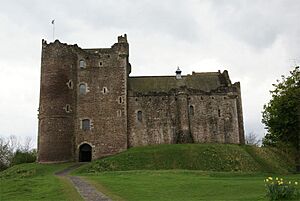
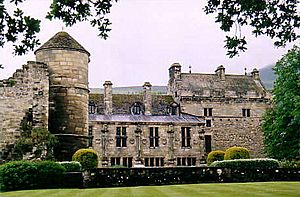
Scottish politics in the late 1300s was often difficult and violent. Robert Stewart spent much of his career gaining more land, power, and titles. He often used strong methods to do so.
When his father, King Robert II, was too ill to rule (from 1371 to 1390), Robert Stewart and his older brother, Lord Carrick, acted as regents. This meant they ruled Scotland almost like kings. Robert Stewart also served as the High Chamberlain of Scotland. He led several military attacks into England.
In 1388, Robert Stewart (then Earl of Fife) took over the guardianship of Scotland from his brother Carrick. Carrick had been badly injured. Robert Stewart wanted to bring law and order to the northern parts of Scotland. He especially wanted to control the actions of his younger brother, Alexander, Earl of Buchan. Alexander was removed from his position as a judge. Robert's son, Murdoch Stewart, soon took over this role. Robert and Murdoch worked together to increase their family's power. This led to conflicts with other powerful families, like the one led by Donald McDonald, Lord of the Isles.
When his brother, Lord Carrick, became King Robert III in 1390, the king was often sick. Because of this, control of the kingdom eventually went to his son and heir, David, in 1399. In 1398, David was given the title Duke of Rothesay. Robert Stewart was given the title Duke of Albany. These were the first two dukedoms ever created in Scotland. Power began to shift away from Robert Stewart and towards his nephew, David.
The Death of the Duke of Rothesay
Soon after, the English invaded Scotland. This caused serious disagreements between Robert Stewart (Duke of Albany) and his nephew David (Duke of Rothesay). In 1401, David was accused of taking money from customs on the east coast. He was also accused of taking money from the empty bishopric of St Andrews. David had also worked with his uncle, Alexander Stewart, Earl of Buchan, to challenge Robert Stewart's power in central Scotland.
When David's time as lieutenant ended in 1402, Robert Stewart acted quickly. David was arrested and imprisoned in Robert Stewart's Falkland Castle. David died there in March 1402. Many people believed that Robert Stewart and another powerful lord, Douglas, were involved in David's death. They were likely worried about David becoming king.
Robert Stewart was officially cleared of any blame by a council. They stated that David died "by divine providence and not otherwise." However, suspicions of foul play continued. These suspicions stayed with David's younger brother, the future King James I of Scotland. These doubts would eventually lead to the downfall of the Albany Stewarts.
John Debrett, a writer in 1805, was sure of Robert Stewart's guilt: "This Robert, Duke of Albany, having obtained the entire government from his brother, King Robert, he caused the Duke of Rothesay to be murdered, thinking to bring the Crown into his own family."
After David's death, King Robert III became worried about his second son, James. James was sent to France for his safety. Debrett wrote: "to avoid the like fate, King Robert resolved to send his younger son James, to France, then about nine years old, who being sea-sick, and forced to land on the English coast...was detained a captive in England eighteen years. At these misfortunes King Robert died of grief in 1406."
Ruling as Regent of Scotland
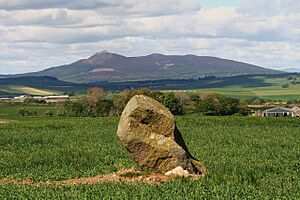
After his brother, King Robert III, died, Robert Stewart ruled Scotland as regent. His young nephew, the future James I of Scotland, remained imprisoned in England for 18 years. Robert Stewart did not try very hard to get his nephew back to Scotland. Instead, he focused on keeping his own power.
Robert Stewart's political success did not end his disagreements with other powerful nobles. One of these was Donald Macdonald, Lord of the Isles. In 1411, Donald led an army of clansmen from the Scottish Isles and Highlands. They fought against the Stewarts. This conflict began because Robert Stewart tried to claim the Earldom of Ross for his second son, John. Donald Macdonald believed he had a stronger claim to the land.
At the Battle of Harlaw on July 24, 1411, both sides suffered heavy losses. This battle was known as "Red Harlaw" because it was so brutal. Donald Macdonald eventually won his claim to the Earldom of Ross.
The Stewart army at Harlaw was led by Robert Stewart's nephew, Alexander Stewart, Earl of Mar. Years later, Alexander Stewart would be part of the group that found Robert Stewart's son, Murdoch Stewart, Duke of Albany, and two of Murdoch's sons guilty of treason. This event almost completely destroyed the Albany Stewarts family.
Marriages and Children
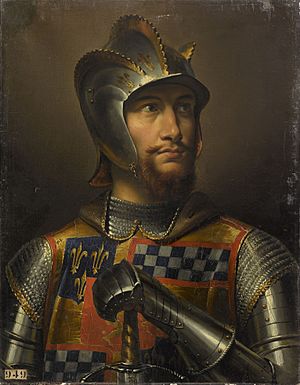
Robert Stewart married twice.
His first marriage was in 1361 to Margaret Graham, Countess of Menteith (1334–1380). She was a wealthy woman and her family's claims to the Earldoms of Menteith and Fife allowed Robert to gain those titles. They had eight children: seven daughters and one son:
- Lady Janet Stewart (married Sir David de Moubray)
- Lady Mary Stewart (married Sir William Abernathy, 6th of Saltoun)
- Lady Margaret Stewart (married Sir John Swinton, 14th of that Ilk)
- Lady Joan Stewart (married Sir Robert Stewart, 1st Lord of Lorne)
- Lady Beatrice Stewart (married Sir James Douglas of Balveny)
- Lady Isobel Stewart (married Alexander Leslie, 7th Earl of Ross, and later Sir Walter de Haliburton, 1st Lord Haliburton of Dirleton)
- Murdoch Stewart, Duke of Albany (1362–1425) (Married Joan Douglas and later Isabel, Countess of Lennox).
- Lady Margery (married Sir Duncan Campbell, 1st Lord Campbell)
Margaret died in 1380. Robert Stewart then married Muriella Keith. They had three children:
- John Stewart, 2nd Earl of Buchan (1381–1424); he fought bravely in France against the English during the Hundred Years War. He was killed at the Battle of Verneuil on August 17, 1424.
- Robert Stewart, Earl of Ross, who died without having children.
- Lady Elizabeth Stewart (married Malcolm Fleming).
Death and What Happened Next

The Duke of Albany died in 1420 at Stirling Castle. He was buried in Dunfermline Abbey in Fife. His son, Murdoch Stewart, Duke of Albany, took over as Duke of Albany and Regent of Scotland.
However, Murdoch's power did not last long. In 1425, King James, who had been held captive in England for 18 years, finally returned to Scotland. King James had Murdoch and most of his family executed for treason. This event almost completely destroyed the Albany Stewarts family.
Murdoch Stewart's only surviving male child was his youngest son, James the Fat. James fled to Ireland after a short rebellion against the King. This rebellion happened because his father and brothers were arrested. James stayed in Ireland and died there in 1429. He was never able to inherit his father's titles because they had been taken away by the King.
Robert Stewart's great-grandson, James "Beag" Stewart (born around 1410–died 1470), eventually received a pardon from the King. He was able to return to Scotland. However, the family never got back their lost lands and wealth. James "Beag" Stewart is an ancestor of the Stewarts of Ardvorlich family near Lochearnside. Their family history is mentioned by Sir Walter Scott in his book A Legend of Montrose.
See also



